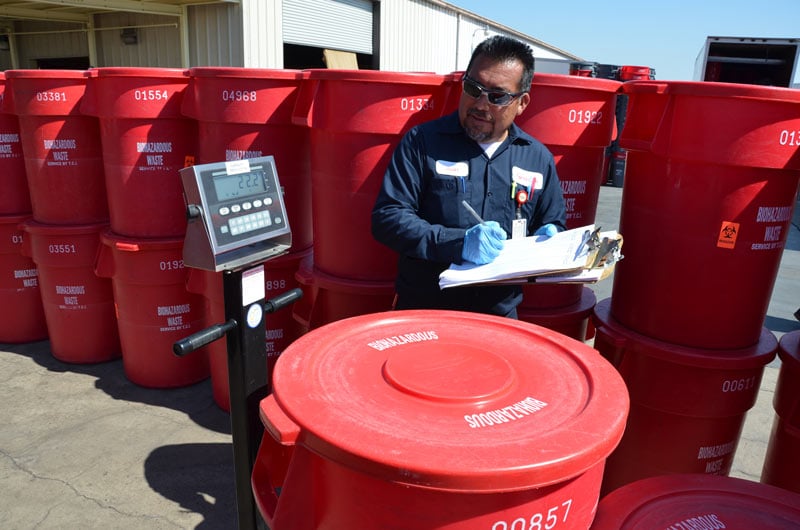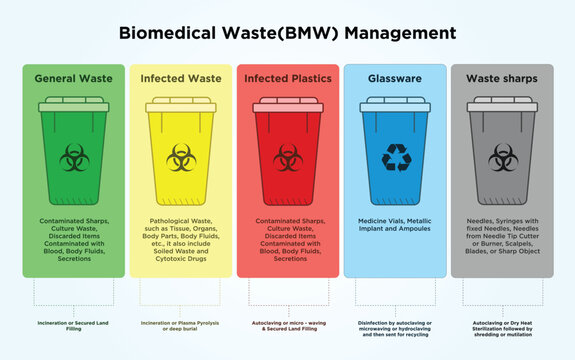Ideal Practices for Medical Waste Monitoring
Clinical waste monitoring is a crucial facet of health care centers' operations to make certain the security of people, staff, and the setting. Executing ideal methods in clinical waste administration is important to decrease the risks related to contaminated materials. This includes appropriate partition and categorization of waste, guaranteeing its secure storage and labeling, adhering to regulatory guidelines, and using reliable disposal methods. By following these finest techniques, medical care centers can decrease the capacity for infections, injuries, and contamination brought on by inappropriate handling and disposal of clinical waste. This intro intends to provide a review of the relevance of best practices for clinical waste monitoring and the succeeding areas will certainly explore each technique thoroughly - medical waste removal.

Segregation and Categorization
In the area of clinical waste management, appropriate segregation and classification are essential techniques for making certain the secure and effective disposal of healthcare-related products. Medical waste is generated from numerous sources, including health centers, centers, laboratories, and various other health care facilities. It is composed of a large range of things, such as needles, syringes, plasters, gloves, and pharmaceutical waste.
Partition includes the systematic splitting up of different kinds of medical waste based upon their qualities and possible dangers. This procedure assists to prevent cross-contamination and makes certain that each sort of waste is taken care of properly. Sharps waste, such as needles and blades, need to be placed in puncture-resistant containers to stop injuries and the spread of infectious illness. Infectious waste, such as blood-soaked bandages or societies, must be set apart and dealt with separately to lessen the threat of spreading microorganisms.
Categorization is the process of categorizing clinical waste right into various groups based upon its potential hazards. These categories may include contagious waste, harmful waste, pharmaceutical waste, and basic waste. By classifying waste, medical care centers can figure out the ideal disposal approaches and make certain conformity with local policies and guidelines.
Proper segregation and classification of medical waste not only shield the health and wellness of health care workers and the general public but also add to the general efficiency and effectiveness of waste administration. It minimizes the threat of mishaps, minimizes ecological effects, and promotes responsible waste disposal techniques.
Correct Storage Space and Labeling
To ensure the effective and risk-free disposal of medical waste, medical care centers need to follow proper storage space and labeling methods. WasteX Medical Waste Disposal. Proper storage and labeling play an essential duty in keeping the stability of medical waste management systems and safeguarding the health and wellness of healthcare workers, people, and the basic public
When it involves storage, it is vital to have actually designated areas especially developed for various kinds of clinical waste. These areas need to be protected, well-ventilated, and outfitted with suitable containers that meet governing standards (medical waste disposal service). Segregation and categorization of waste need to also be taken right into consideration to prevent cross-contamination and possible threats

Routine monitoring and evaluation of storage areas and containers are necessary to recognize any kind of concerns or offenses. Personnel ought to be trained on correct storage space and labeling methods, emphasizing the significance of compliance with procedures and regulations.
Safe Transportation and Handling
Making certain the safe and appropriate transportation and handling of clinical waste is essential for maintaining the honesty of waste management systems and securing the health and wellness of all involved. Medical waste, which consists of things polluted with infectious products, pharmaceuticals, and various other dangerous substances, need to be carried in a manner that protects against leakages, spills, and possible contamination.
To accomplish secure transportation and handling, numerous finest techniques ought to be adhered to. It is important to make use of leak-proof and puncture-resistant containers that are especially developed for clinical waste. These containers should be appropriately sealed and identified to avoid any unintended exposure or mishandling. Additionally, waste must be segregated based on its nature and type to avoid cross-contamination.
Throughout transport, it is essential to make sure that waste containers are firmly attached and saved in a stable way. Cars utilized for moving medical waste ought to be furnished with proper security features, such as spill containment systems, to reduce the danger of any type of leaks or spills. Motorists must obtain training on correct handling and emergency situation feedback treatments to properly resolve any kind of unforeseen events.
Additionally, the transportation and handling of medical waste ought to comply with all relevant regulations and guidelines set forth by regional, state, and government authorities. WasteX Medical Waste Disposal. medical waste disposal service. Routine evaluations and audits should be conducted to assess conformity and identify any areas for enhancement
Compliance With Regulatory Standards
Preserving conformity with regulative guidelines is crucial for efficient medical waste monitoring. These guidelines are established to protect public wellness and the atmosphere by ensuring that clinical waste is properly taken care of, treated, and disposed of. Conformity with regulatory standards helps to prevent the spread of transmittable illness, decrease potential threats, and decrease the total impact of clinical waste on the setting.
To accomplish compliance, health care facilities need to stay educated regarding the certain policies controling medical waste monitoring in their territory. These regulations might differ from country to nation, and even within different states or areas. It is essential for medical care centers to have a thorough understanding of these guidelines and to carry out suitable techniques and procedures to ensure conformity.
One secret aspect of conformity is the appropriate partition and labeling of various kinds of clinical waste. This consists of dividing sharps from various other waste, as well as classifying waste based upon its possible dangers. Medical care facilities should additionally guarantee that medical waste is kept in proper containers which these containers are appropriately classified and secured.
Additionally, compliance with regulatory standards calls for medical care centers to develop appropriate training and education and learning programs for team member associated with clinical waste administration. This includes providing training on waste partition, managing, and disposal treatments, along with the correct use individual protective equipment.
Regular tracking and audits are also vital to ensure ongoing conformity with governing standards. This includes conducting regular inspections of waste storage space locations, documenting waste management procedures, and maintaining documents of waste disposal.
Reliable Disposal Techniques
Healthcare centers need to employ reliable disposal approaches for appropriate management of clinical waste. Incorrect disposal of medical waste can posture significant health and wellness and environmental risks. There are several methods that can be made use of to effectively deal with medical waste, making sure the safety of health care employees, clients, and the public.
One generally made use of method is incineration. Burners can safely shed clinical waste at heats, decreasing the quantity and destroying any potentially harmful pathogens. Incineration can be costly and may launch damaging toxins into the air if not properly controlled.
An additional approach is autoclaving, which includes subjecting the waste to high-pressure vapor. This process eliminates germs, viruses, and various other microorganisms, providing the waste safe for disposal in normal waste streams. Autoclaving is a reliable and eco-friendly approach, but it needs specialized tools and qualified employees.
Chemical disinfection is likewise used in many cases, where liquid chemicals are related to the waste to decontaminate it. This method is much less frequently made use of because of worries about the effectiveness of chemical disinfection and the possibility for chemical residues to contaminate the environment.
Along with these methods, healthcare facilities ought to additionally implement correct segregation, packaging, and labeling of clinical waste to guarantee its secure handling and disposal. Routine training and education and learning of team on correct waste administration methods are essential to preserving view website efficient disposal approaches.
Conclusion
Finally, carrying out ideal practices for medical waste administration is crucial for guaranteeing the security of health care employees, people, and the setting. By effectively classifying and setting apart waste, keeping and identifying it properly, guaranteeing risk-free transportation and handling, abiding by regulatory guidelines, and employing efficient disposal methods, healthcare facilities can successfully manage and decrease the threats connected with clinical waste. It is vital for medical care companies to focus on and adhere to these ideal methods to maintain a sustainable and risk-free healthcare setting.
Medical waste management is a critical facet of health care facilities' procedures to ensure the security of people, personnel, and the setting. Executing ideal methods in medical waste management is vital to reduce the threats connected with hazardous waste. These classifications may consist of contagious waste, hazardous waste, pharmaceutical waste, and general waste.In conclusion, applying finest techniques for medical waste management is crucial for making certain the security of medical care workers, people, and the environment. By appropriately classifying and setting apart waste, saving and labeling it properly, ensuring risk-free transportation and handling, complying with regulative standards, and employing efficient disposal techniques, healthcare facilities can properly manage and lessen the threats connected with clinical waste.